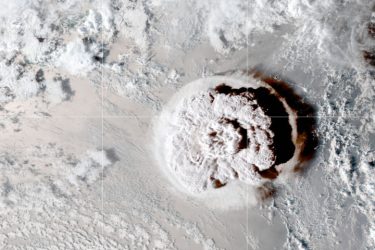
Research from the University of Washington shows that signals from the upper atmosphere could improve tsunami forecasting and, someday, help track ash plumes and other impacts after a volcanic eruption.
A new study analyzed the Hunga Tonga-Hunga Ha’apai eruption in the South Pacific earlier this year. The Jan. 15, 2022, volcanic eruption was the largest to be recorded by modern equipment. Ash blanketed the region. A tsunami wave caused damage and killed at least three people on the island of Tonga. It also had unexpected distant effects.
No volcanic eruption in more than a century has produced a global-scale tsunami. The tsunami wave from the underwater eruption was first predicted as only a regional hazard. Instead, the wave reached as far as Peru, where two people drowned.
Results of the new study, published this fall in Geophysical Research Letters, uses evidence from the ionosphere to help explain why the tsunami wave grew larger and traveled faster than models predicted.
Read more at UW News »
